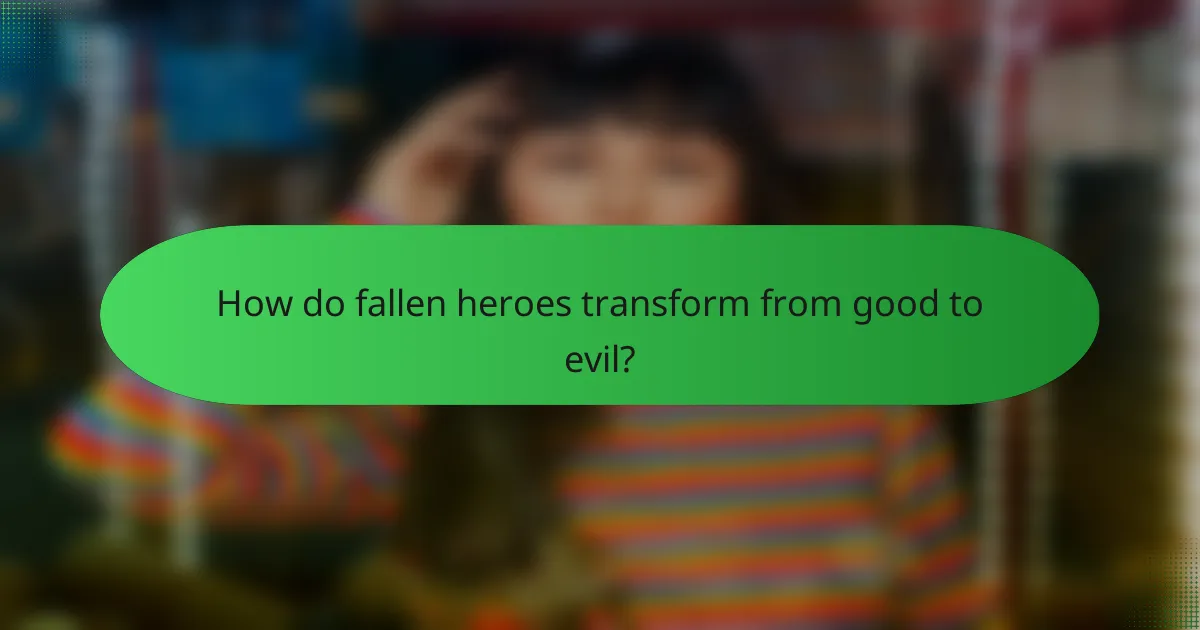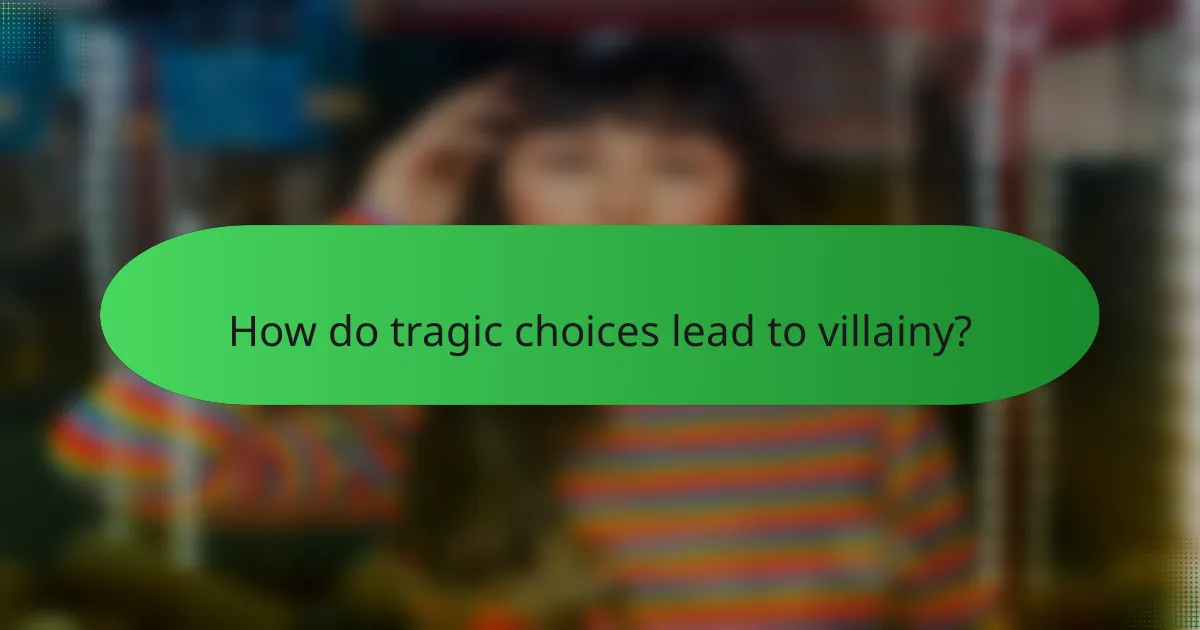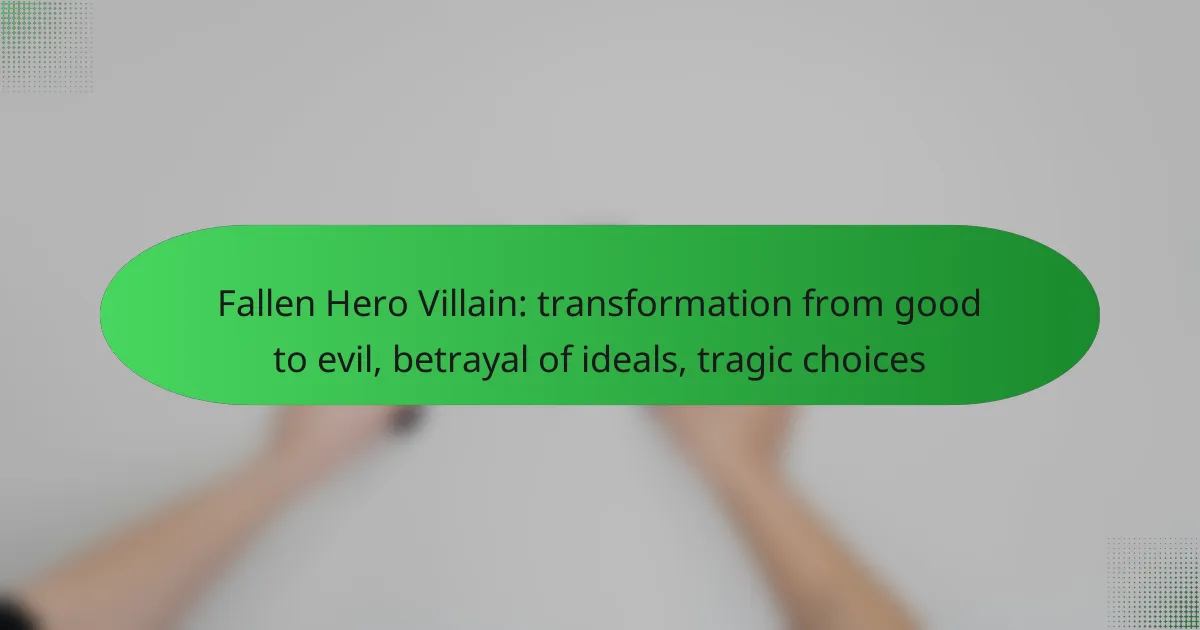The journey of a fallen hero is marked by a profound transformation from good to evil, driven by psychological struggles and external pressures. As they grapple with moral dilemmas and make tragic choices, these once-noble figures betray their core ideals, leading to devastating consequences that resonate deeply within their lives and relationships.

How do fallen heroes transform from good to evil?
Fallen heroes transform from good to evil through a complex interplay of psychological factors, personal crises, and external influences. This transformation often involves a betrayal of their core ideals and tragic choices that lead them down a dark path.
Psychological manipulation
Psychological manipulation plays a crucial role in the transformation of fallen heroes. They may be subjected to coercive tactics that exploit their vulnerabilities, leading them to question their beliefs and values. For instance, a once-noble leader might be swayed by persuasive rhetoric that distorts their moral compass.
Manipulators often use guilt, fear, or flattery to achieve their ends, creating an environment where the hero feels isolated and pressured to conform. This can result in a gradual erosion of their original ideals, making it easier for them to embrace darker choices.
Loss of faith in ideals
A significant factor in a hero’s fall is the loss of faith in their ideals. When faced with repeated failures or betrayals, they may begin to doubt the very principles that once guided them. This disillusionment can lead to a sense of hopelessness, prompting them to abandon their moral framework.
For example, a hero who fights for justice may become cynical after witnessing corruption within the system they serve. This shift can make them more susceptible to embracing unethical actions as they seek alternative means to achieve their goals.
Influence of negative relationships
Negative relationships can significantly impact a hero’s trajectory towards evil. Surrounding themselves with toxic individuals can reinforce destructive behaviors and thoughts. These relationships often foster an environment where negative influences thrive, leading to poor decision-making.
For instance, a hero might be drawn into a group that encourages ruthless ambition, gradually shifting their perspective and values. The desire for acceptance within this group can overshadow their commitment to their original ideals.
Desire for power
The desire for power is a potent motivator that can lead heroes astray. As they gain influence, the temptation to wield that power for personal gain can become overwhelming. This pursuit often blinds them to the consequences of their actions, pushing them further into moral ambiguity.
Heroes may start justifying unethical decisions as necessary for achieving greater goals, leading to a slippery slope of corruption. The allure of power can overshadow their initial intentions, transforming them into the very villains they once opposed.
Traumatic experiences
Traumatic experiences can catalyze a hero’s transformation into a villain. Events such as loss, betrayal, or violence can deeply affect their psyche, altering their worldview. These experiences may lead to a hardened perspective, where compassion is replaced by a desire for revenge or control.
For example, a hero who suffers a personal tragedy may become embittered, viewing the world through a lens of distrust and aggression. This shift can make them more likely to embrace dark paths as they seek to regain a sense of power or justice.

What are the key traits of fallen heroes?
Fallen heroes are characterized by their complex moral dilemmas, compelling leadership qualities, and relatable backstories that often lead to their tragic downfall. These traits highlight the transformation from good to evil, showcasing how betrayal of ideals can stem from personal choices and external pressures.
Complex moral ambiguity
Fallen heroes often navigate a landscape filled with moral ambiguity, where right and wrong are not easily defined. Their decisions may stem from a desire to achieve a greater good, even if it means compromising their original values. This complexity makes them relatable, as many people face similar dilemmas in their lives.
For example, a once-noble leader may resort to unethical tactics to protect their community, believing that the ends justify the means. This internal conflict can resonate with audiences, prompting them to reflect on their own moral choices.
Charismatic leadership
Charismatic leadership is a hallmark of fallen heroes, as they often possess the ability to inspire and rally others around their vision. Their charm and persuasive skills can mask their darker intentions, making it easier for them to manipulate followers. This magnetic quality can create a strong emotional connection with their audience.
Consider a political figure who initially champions justice and equality but later exploits their influence for personal gain. Their charisma allows them to maintain a loyal following, even as their actions diverge from their original ideals.
Relatable backstory
A relatable backstory is crucial in understanding the transformation of a hero into a villain. These narratives often involve personal loss, betrayal, or trauma that shape their worldview and decisions. By presenting a backstory that audiences can empathize with, fallen heroes become more than just villains; they are seen as tragic figures.
For instance, a character who loses a loved one to violence may initially fight for justice but eventually turns to vengeance. This journey from heroism to villainy underscores the impact of personal experiences on moral choices, making their downfall poignant and impactful.

What are the consequences of betrayal of ideals?
Betraying one’s ideals often leads to profound and far-reaching consequences, including loss of trust, isolation, and internal turmoil. These outcomes can significantly impact relationships and personal well-being, making it crucial to understand the implications of such actions.
Loss of trust from allies
When an individual betrays their ideals, allies may feel deceived and lose faith in that person’s integrity. Trust is foundational in any relationship, and once broken, it can be challenging to rebuild. For instance, a leader who compromises their values for personal gain may find their followers questioning their motives and loyalty.
This loss of trust can manifest in various ways, such as reduced collaboration, withdrawal of support, or even public condemnation. The ripple effect can extend beyond immediate relationships, affecting reputations and future opportunities.
Isolation from former supporters
Betrayal often leads to isolation, as former supporters may distance themselves to avoid association with someone they perceive as untrustworthy. This isolation can be both social and professional, limiting access to networks that once provided support and resources. For example, a once-respected activist who abandons their cause may find themselves ostracized by the very community they once championed.
As isolation deepens, the individual may struggle to find new allies, leading to a cycle of loneliness and despair. The absence of a support system can exacerbate feelings of regret and reinforce the consequences of their choices.
Internal conflict and guilt
Individuals who betray their ideals often experience significant internal conflict and guilt. This emotional turmoil arises from the clash between their actions and their core beliefs, leading to a sense of dissonance. For instance, a person who once advocated for justice may feel profound remorse after compromising their principles for personal benefit.
Over time, this internal struggle can manifest as anxiety, depression, or a crisis of identity. It is essential for individuals facing such conflicts to seek support, whether through counseling or open discussions with trusted friends, to navigate their feelings and work towards reconciliation with their values.

How do tragic choices lead to villainy?
Tragic choices often propel individuals from heroism to villainy by forcing them to make decisions that betray their core values. These moments of desperation can lead to misguided actions that ultimately result in harm to themselves and those they care about.
Desperation in critical moments
Desperation can cloud judgment, leading individuals to make choices they would normally reject. In high-stakes situations, the pressure to act quickly can result in decisions driven by fear rather than reason. For example, a once-noble character might resort to unethical means to save a loved one, believing it to be the only option.
This urgency can create a slippery slope where each decision becomes increasingly compromised, distancing the individual from their original ideals. The initial act of desperation may seem justified, but it often sets off a chain reaction of further moral compromises.
Misguided sacrifices
Misguided sacrifices occur when individuals believe they must give up their principles for a greater good. This often stems from a distorted perception of what is necessary to achieve a desired outcome. A hero might sacrifice their integrity, thinking that the end justifies the means, only to find that the consequences are far more damaging than anticipated.
For instance, a character might betray a friend to gain power or resources, believing this will ultimately benefit their cause. However, this betrayal can erode trust and lead to isolation, further entrenching them in villainy.
Unintended harm to loved ones
Tragic choices can inadvertently cause significant harm to loved ones, amplifying the character’s descent into villainy. When individuals prioritize their misguided goals over the well-being of those close to them, they risk alienating the very people they sought to protect. This can lead to feelings of guilt and resentment, further complicating their moral landscape.
For example, a hero turned villain might justify their actions by claiming they are doing it for their family’s sake, only to end up causing emotional or physical harm to them. This unintended fallout can create a cycle of regret and villainy, making redemption increasingly difficult.

What are famous examples of fallen heroes in literature?
Fallen heroes in literature are characters who transition from virtuous to villainous, often due to betrayal of their ideals or tragic choices. Notable examples include Anakin Skywalker from Star Wars and Walter White from Breaking Bad, both of whom illustrate the complexities of moral decline.
Anakin Skywalker in Star Wars
Anakin Skywalker embodies the classic fallen hero archetype, starting as a promising Jedi Knight before succumbing to the dark side. His transformation into Darth Vader is driven by fear, manipulation, and a desire for power, leading him to betray his friends and ideals.
Key moments in Anakin’s journey include his secret marriage to Padmé Amidala and his eventual turn against the Jedi Order. These choices reflect a tragic struggle between love and ambition, showcasing how personal desires can lead to catastrophic consequences.
Walter White in Breaking Bad
Walter White begins as a mild-mannered chemistry teacher who turns to cooking methamphetamine after a cancer diagnosis. His descent into the criminal underworld illustrates how desperation can corrupt even the most principled individuals, as he prioritizes financial gain over family and morality.
Walter’s transformation is marked by a series of increasingly unethical decisions, including manipulation and violence. His journey serves as a cautionary tale about the seductive nature of power and the ease with which one can abandon their core values.
